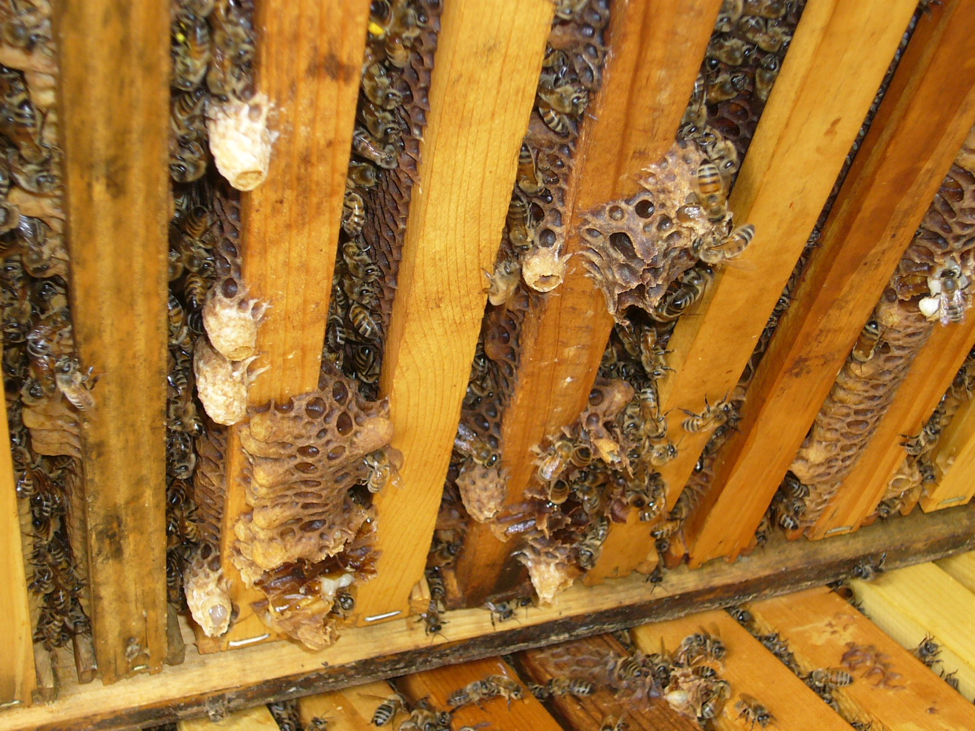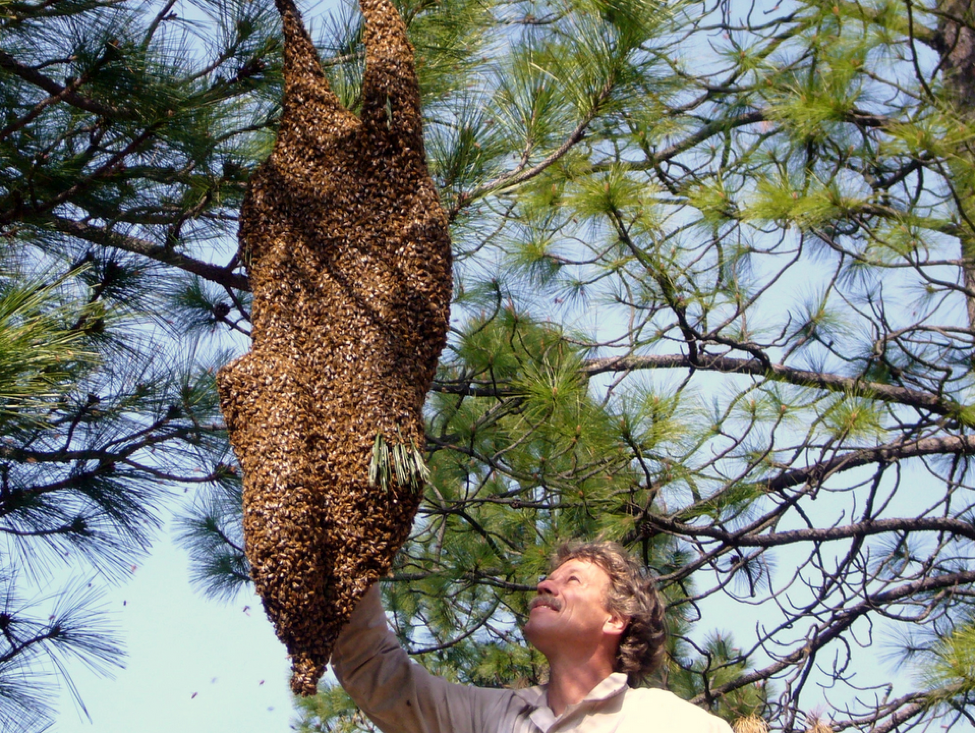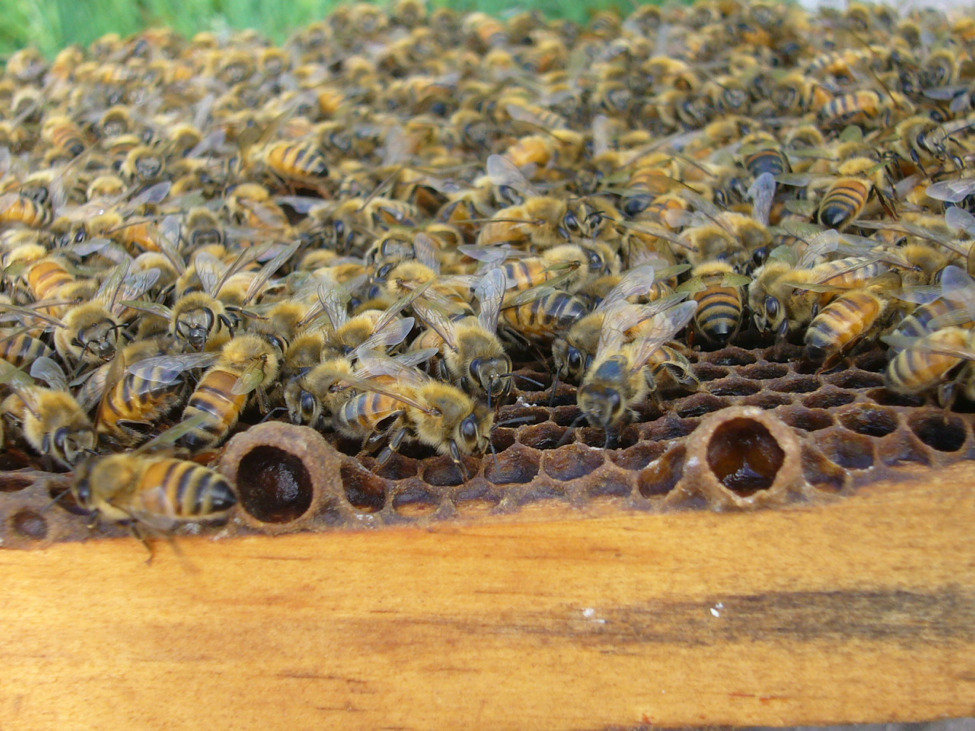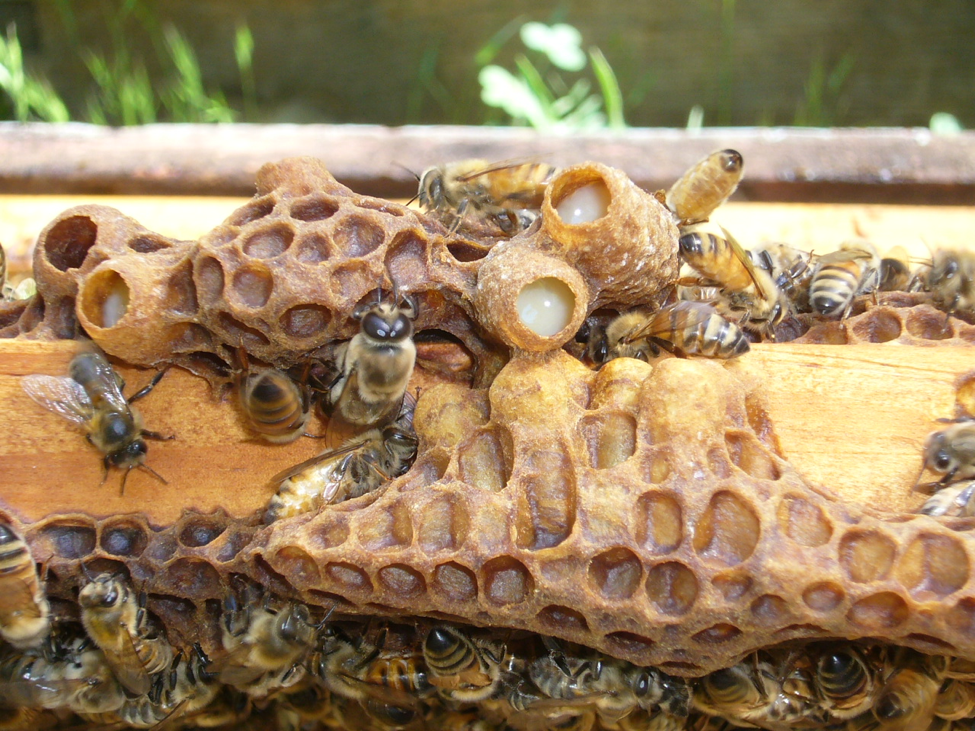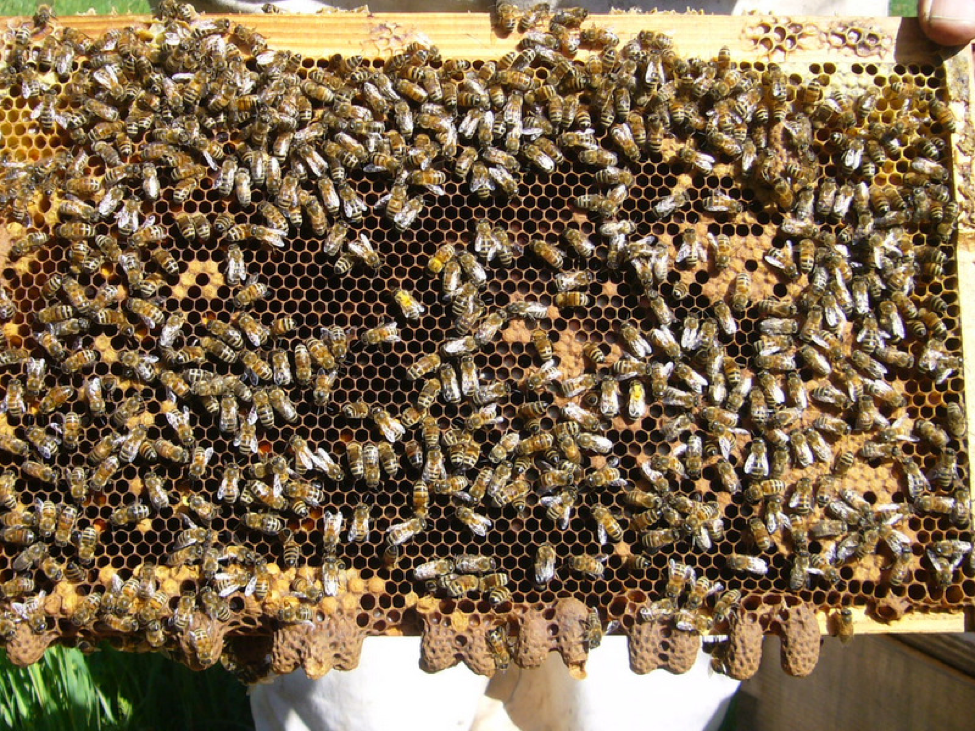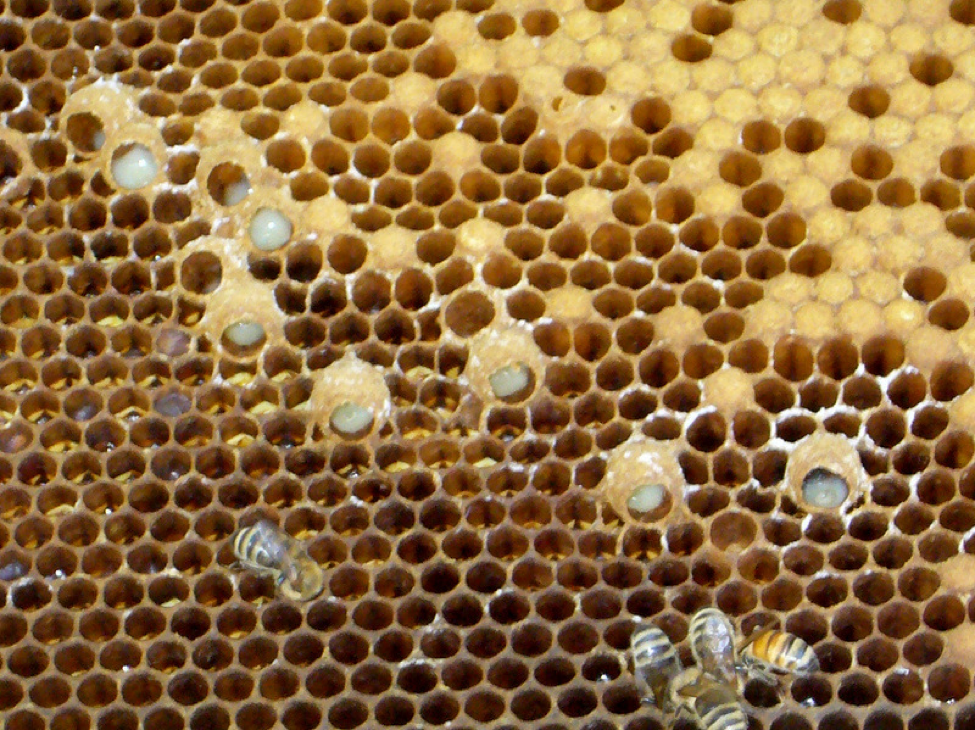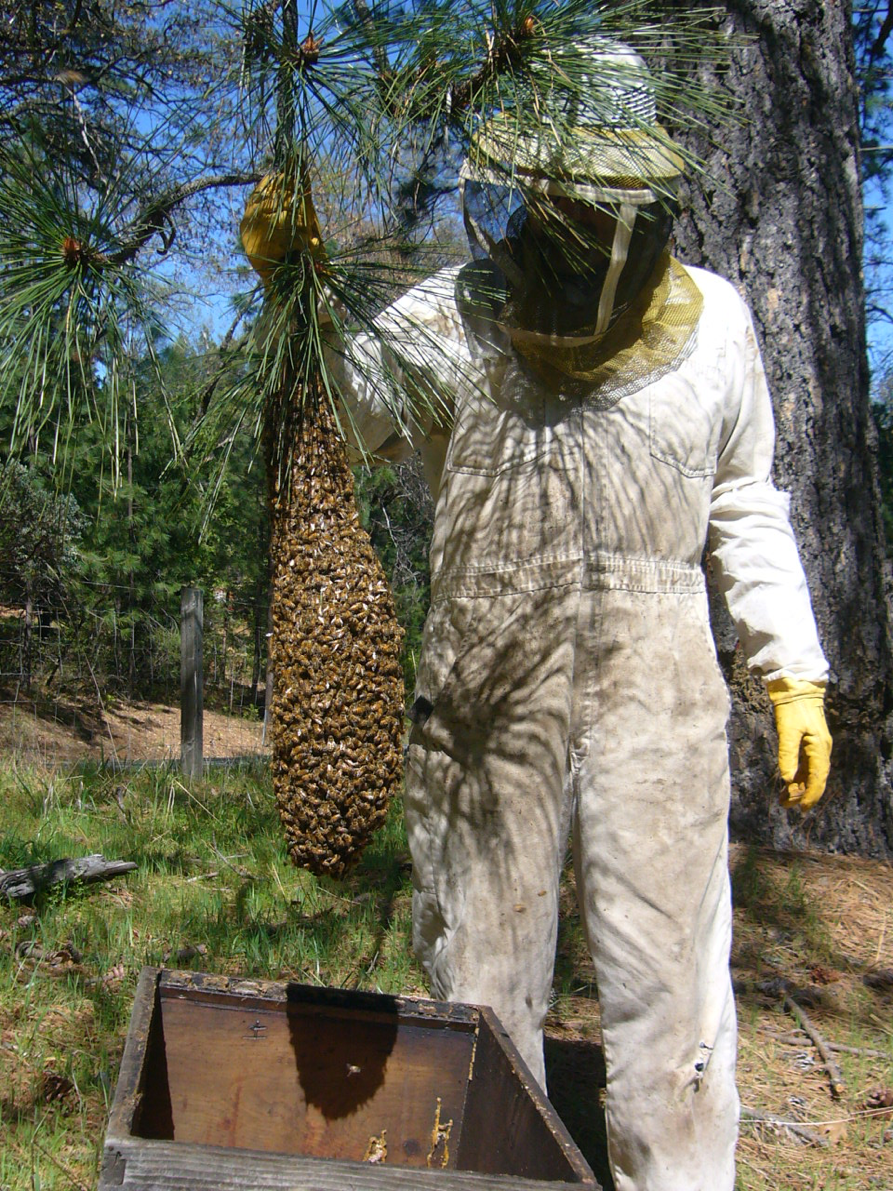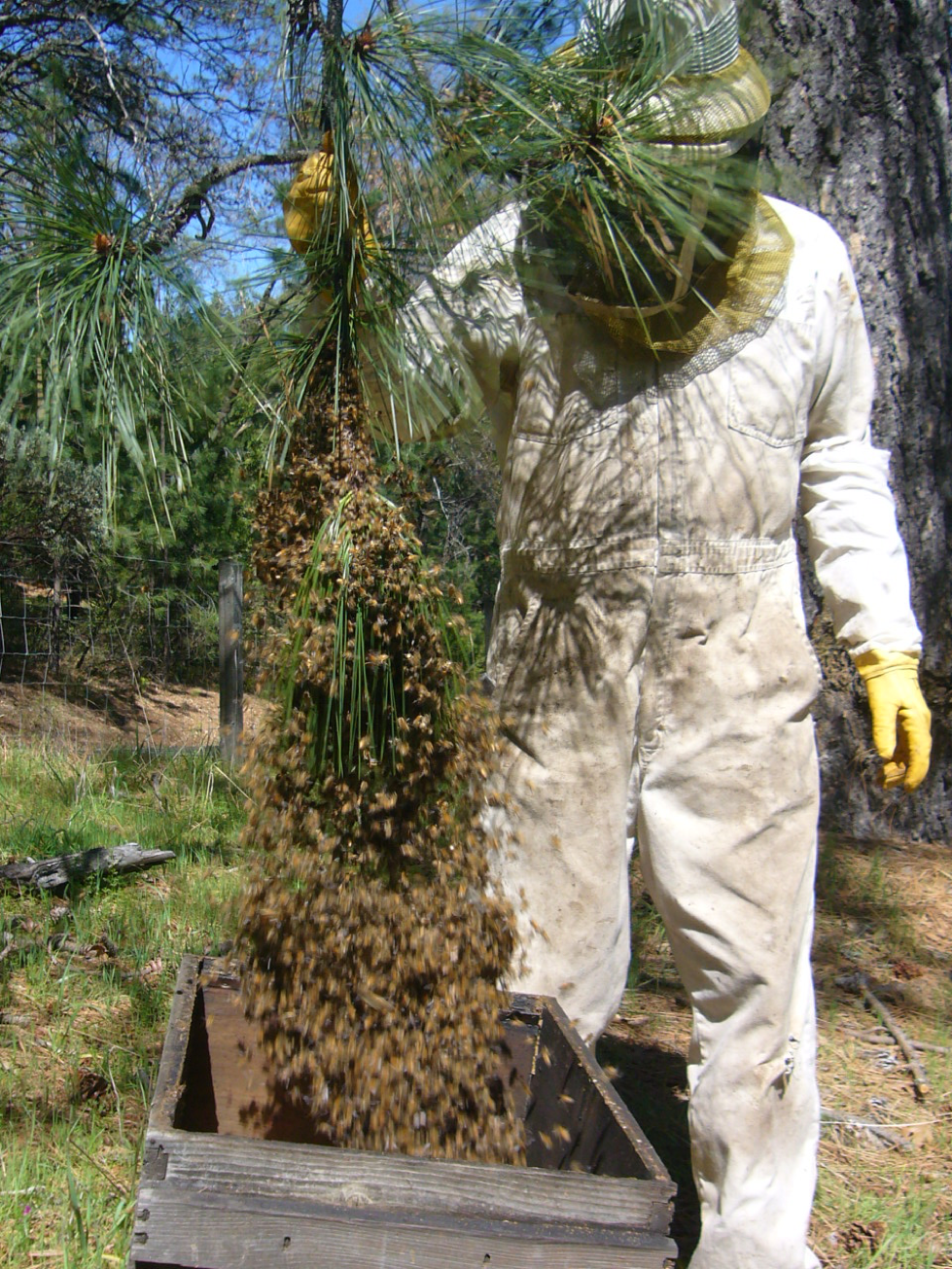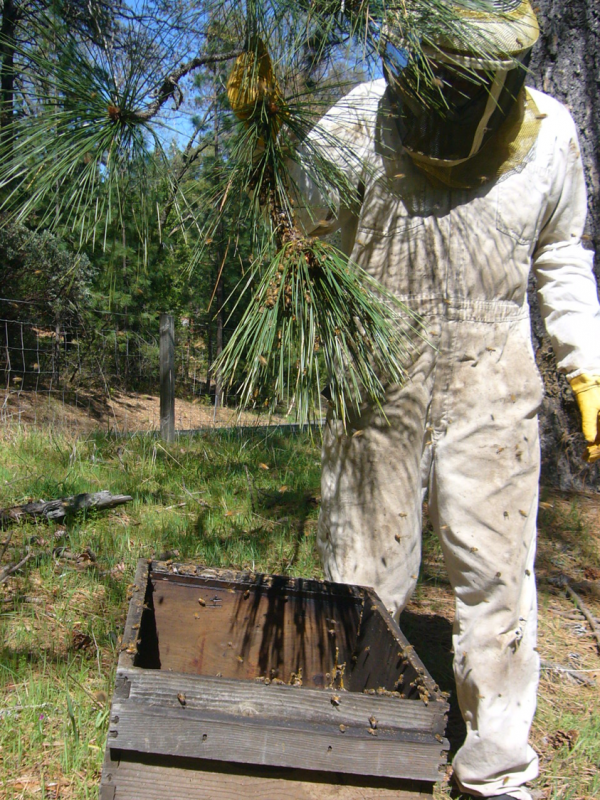Understanding Colony Buildup and Decline: Part 7a – The Swarming Impulse
Understanding Colony Buildup and Decline – Part 7a
The Swarming Impulse
Randy Oliver
ScientificBeekeeping.com
First Published in ABJ in Aug 2015
CONTENTS
The Swarming Impulse
Terminology
Reproductive Swarming And Emergency Swarming
The Effect Of Swarming Upon The Colony
Predicting Swarming
Issuance Of The Swarm
Acknowledgements
References
One of the main challenges of keeping bees for honey production is to manage one’s hives to reach maximum strength by the start of the main honey flow, yet to somehow keep from blowing it by allowing those strong colonies to swarm.
An unmanaged colony of bees, should it survive the winter and successfully build up its population, must focus upon reproduction. Biologically, that means getting some of its genes into the next generation. There are two ways of doing so—by producing thousands of drones, on the chance that some of them might “get lucky” and mate with virgin queens from other colonies, or by undertaking the risky venture of sending off the mother queen and half the workers as a swarm.
Given good conditions, most wild (or feral) honey bee colonies will swarm more than once a season (if one counts the afterswarms [1]). Nature applies strong selective pressure for this behavior, since those colonies that are best at repopulating an area after a decimation event (such as plague, drought, forest fire, or a severe winter) are those whose genes will dominate the next generations.
But to the beekeeper, swarming is less desirable. The downside of swarming is that if it occurs shortly before (or during) the main honey flow, then the population of the hive is temporarily reduced, and honey production will suffer accordingly. As a result, bee breeders tend to select against the swarming trait, and we beekeepers attempt to prevent swarming through our management practices.
The Swarming Impulse
Swarming is a biological imperative once a colony has reached a certain size and food resources are abundant. Tropical races of bees tend to swarm more frequently, since they are less concerned about stocking away winter stores (they are also much more likely to abscond if faced with a dearth). The European races are a bit more cautious (since they don’t normally abscond)–unless they keep their populations large enough to put away enough honey reserves, neither the parent colony nor the swarm will survive the winter. Accordingly, in this article I’m going to focus upon our managed European stocks [2].
By better understanding the biology of the swarming impulse, the beekeeper can make informed decisions regarding management options to minimize the event (but from personal experience, I can assure you that you are no more likely to completely prevent swarming than you are to prevent teenagers from following their innate biological urges).
To the beekeeper, the first indication of the swarming impulse is usually that the colony starts to build queen cells on the bottom bars (Fig. 1).
Figure 1. Colonies typically build swarm cells in the space between the brood chambers. This is the best place to look, but be aware that there may also be cells where other irregularities occur between the brood combs
The presence of queen cells is an intermediate step of the swarm impulse, and may or may not culminate with the actual issuing of a swarm. More importantly, it’s better for the beekeeper to be proactive, and avert the colony’s impulse to swarm before they even think about building cells.
To me, the fascinating thing about swarming is trying to understand exactly how the colony “mind” determines when to initiate the behavior, and how it translates that decision to the individual workers who then construct the queen cells, and then feed them or tear them down. But before we get into that, let’s first define some terms…
Terminology
Prime swarm: the first swarm to leave, containing the overwintered “old” queen. Prime swarms are typically the largest swarms, and may contain 10 pounds of bees (Fig. 2).
Figure 2. A typical California swarm. Just kidding—we watched a few swarms in a yard coalesce into a monster, and then move from tree to tree, dropping walnut-sized balls of bees (each surrounding a queen), which we picked up and used to start 6 new colonies, using the bees from the swarm). This is not trick photography—I’ve seen the weight of a large swarm snap a 1” hardwood tree trunk.
Afterswarm: a normally smaller swarm that issues following the prime swarm (typically 10-15 days later).
Late season swarms: swarms which issue after the main honey flow. As Winston observes: “This is a curious behavior, since it is highly unlikely that such swarms and the new colonies that they issue from [referring to colonies previously founded as swarms earlier in the season] will survive the winter.”
Usurpation swarms: swarms which invade and usurp an established colony [3]. This is a plausible explanation for how the above behavior could be adaptive.
A note on terminology: should the swarm that leaves be called the “parent” or “daughter” colony? It is the parent queen that actually issues along with half the parent colony, leaving her daughters behind to fight it out. But most beekeepers refer to the original hive as the “parent hive.” I will follow that terminology in order to avoid confusion.
Queen cup: a downward-facing base of a queen cell, prepared to receive an egg (Fig. 3).
Figure 3. Empty queen cups along the bottom bar of a brood comb. Colonies tend to build plenty of these during spring (or other times of the year) in initial preparation for swarming or supersedure, but may or may not actually use them. Only when they are “wet” with jelly and a larva (Fig. 4) is the colony seriously starting to commit to swarming.
Figure 4. Swarm cells “wet” with jelly and a larva. At this point, swarming is imminent, unless conditions change to cause the colony to decide to throw it into reverse and consume them.
Queen cell: Any downward-facing cell containing an immature queen (Fig. 5). Queen cells are built by the bees in response to three different scenarios.
Figure 5. Some exceptionally elongated queen cells. They are swarm cells, but in an unusual location.
Swarm (reproductive) cells: queen cells created in preparation for swarming (colony reproduction), typically initiated in dedicated cups on the lower edges of a brood comb (Fig. 6).
Figure 6. A row of swarm cells (in a more “normal” location) shortly after the issuing of the prime swarm (note that the 5th cell from the right has already emerged). Depending upon the strength of the colony, the remaining unemerged queens may be killed in their cells, or allowed to emerge and either form afterswarms or fight to become the new mother queen of the colony.
Supersedure cell: A queen cell raised by the colony with the intent of replacing a failing, injured, or otherwise undesirable queen (Fig. 7). Russian bees are noted for frequently building and tearing down supersedure cells—apparently keeping immature reserve queens on hand “just in case.” Unless your queens are marked, you may not notice the degree of supersedure that naturally occurs.
Figure 7. Supersedure cells are typically single cells built on the face of the comb. Sick colonies will often supersede the queen, apparently in an attempt to bring “new blood” into the hive.
Of note is that there is no particular reason for a queen to fight with her supersedure daughter, since they share at least half their genes, and are not really in competition. This may be why we so often see a mother and daughter queen happily ignoring each other. On the other hand, sister queens fight aggressively in order to become the sole mother of a colony.
Emergency cell: A queen cell created in response to the loss or removal of a queen. These are typically built by modifying an existing cell containing a newly-emerged worker larva (Fig. 8).
Figure 8. Emergency queen cells are formed by floating an existing young larva to the top of her cell by adding jelly, then extending the cell in a downward direction. The bees start a number of emergency cells, and then later cull out many of them.
Reproductive Swarming And Emergency Swarming
Colonies producing emergency cells following the loss of their queen exhibit a number of behaviors similar to those in colonies preparing for afterswarming. The study of such similarities may help us to understand the cues that cause bees to initiate certain behaviors, and thus how the colony “thinks.”
Punnett and Winston [4] speculated that:
One possible explanation is that workers are not able to perceive differences between queen loss due to death and queen loss due to swarming. Thus, colonies may behave as if they were in an afterswarming situation following queen loss.
Surprisingly, the researchers also found that when a colony is made queenless, some emergency cells are built in queen cups (rather than by extending worker cells), meaning that they were started after the disappearance of the queen. The researchers concluded that workers must move either eggs or newly-emerged larvae into preexisting queen cups [5]. What, you say, workers move larvae? Apparently so. The only other possible way for larvae to appear in the cells would be by workers laying fertile eggs [6], which does not appear to be the case, since a number of researchers have noted that no additional emergency cells are initiated after 4 days of queenlessness [7].
Of interest is that this behavior is exhibited to an even greater extent by Africanized bees, suggesting that it is an innate ancestral behavior. What intrigues me is that it raises the question as to what extent the queen is actually involved in the swarm impulse—she apparently is not even required to lay eggs in the prepared swarm cups (although this is the normal way it is done), since the workers are able to move them (or young larvae) there themselves.
Biological question: if swarm cell formation does not depend upon the queen voluntarily laying eggs in them, then the implication is that the colony, independently of its queen, can decide if and when to swarm. Although the queen generally does lay eggs in the cells, and inspects the development of her daughter queens, it appears that it is the workers who are largely running the show. It is they who build the cells and feed the daughter queens, restrict the queen’s diet prior to swarming, and finally goad her into flight. It could well be that in the process of swarming, the superorganism may act largely independently of its mother/ovary (the queen), although they are certainly reading some of her pheromonal signals. The question to me is to what degree the queen is necessarily involved in the decision making regarding the swarm impulse and execution. A second question is whether the workers apply a pheromone into the queen cups to “tell” the queen when and where to place an egg.
The Effect Of Swarming Upon The Colony
Over 50% of the workers leave with the swarm, most of them being less than 10 days of age. The loss of this nurse force then results in elevated mortality of the remaining young brood (over 40% may perish). This is quite a hit to the colony population. There is less immediate impact of honey loss to the swarm; by my math perhaps a couple of pounds.
Biological question: I find it of interest that the workers engorge with nectar for about 10 days prior to the actual issuance of the swarm. This finding suggests that the colony population initiates other preparations (besides producing queen cells) well in advance of departure. How this memo is communicated to each individual bee remains an open question, but raises the additional question of whether there are other physiological changes that take place in pre-swarming bees.
But since the colony is full of sealed brood at the time of swarm issuance, its population usually recovers rapidly, should it not continue to issue afterswarms. Unfortunately, the more brood present, the greater the chance of afterswarming [8]. Up to four more afterswarms may leave over the next several days, each containing one or more virgins (I once recovered something like 18 queens from one exceptionally large combined swarm). A colony will normally issue afterswarms only to the extent that it continues to maintain an adequate population, but I do occasionally see a colony appear to “swarm itself to death.”
Practical application: it is frustrating to watch your strongest colonies hit the trees just before the main flow. Rather than putting honey into your supers, those bees (should you not catch the swarm (Figs. 9-11)) are now in competition with your hived colonies.
Figure 9. A perfect low-hanging swarm, a hive ready to receive it positioned below and with the cover off, with an empty super placed on top to act as a funnel.
Figure 10. One quick shake to dislodge the bees…
Figure 11. Ah, I wish they were all that easy!
There will also be a brood break of from 15-25 days (until all afterswarms have issued, and a new queen finally gets mated and starts laying). This brood break has a delayed effect of further reducing the adult population (when recruitment of replacement workers is curtailed beginning three weeks later).
Remember from my previous article about weaker colonies “catching up” with stronger colonies during the linear buildup phase? A colony that reaches peak population in advance of the main flow may as well swarm and attempt to recover its population in time for the main flow. Weaker colonies, by not swarming, may then be able to surpass the formerly strong colonies in honey production.
Practical application: as out-of-state almond pollinators are well aware, having strong colonies early in March is not necessarily a good thing. We California beekeepers shift quickly from building up our colonies for almond pollination to trying to keep them in their boxes after the bloom is over. It’s all about timing—there’s no sense in building up colonies too early in the season, unless you want to make increase. Ideally, you’d time the buildup so that all your hives are just approaching maximum population when your main honey flow begins.
Let’s not forget varroa: There’s conflicting data on the effect of swarming on varroa. Obviously, some mites get carried off with the swarm, and the brood break further reduces the mite population. But let’s do the math. At the time of swarming, the colony is chock full of sealed brood (lots of it drone brood), so perhaps 2/3rds of the mites will be in the brood, leaving only 1/3 on the adult bees. Say that half the adult bees leave with the swarm. That means that roughly 1/6 of the mites go with the swarm, leaving 5/6 in the parent hive. If you are lucky enough to hive the swarm, you now have two “new” colonies. But one now starts with 5x as many mites in it, and likely should be managed more aggressively for varroa.
Predicting Swarming
Most swarming in any area occurs during a period of only a few weeks, generally keyed to plant phenology (the timing of bloom). In my area, swarm season usually occurs from mid April to mid May (when our main flow typically starts). But this season, drought and poor flight weather resulted in two peaks in swarming, one early, and a second peak in mid June. This was apparently due to lack of forage during the “normal” swarm season, so colonies curtailed swarming until a decent nectar flow began.
Practical application: learn from experienced beekeepers when to “expect” swarming, but realize that the timing can vary greatly from year to year.
Colonies typically swarm shortly after the first queen cell is sealed, but may leave earlier or later, depending upon weather conditions. Colonies may tear down cells to delay swarming, or lose the swarm impulse altogether (this can be easily observed at the end of almond pollination, when colonies left in the now forage-deficient orchards will quickly tear down their cells). Colonies will also sometimes keep virgins imprisoned in their cells, and the beekeeper can easily hear them piping at one another.
Practical application: continually lift your upper brood chambers of your strongest colonies to check for “wet” queen cells on the bottom bars (don’t worry about “dry” queen cups, which don’t indicate that the colony is yet serious about swarming). The presence of swarm cells containing a larva and jelly is your best cue that that the swarm impulse is in full gear. The bees may well tear these cells down should conditions change, but they are a call to action for the observant beekeeper.
The question then is what one can do to either prevent or reverse the swarm impulse. I will cover that topic in the next installment.
Issuance Of The Swarm
In this series, I’m only going to discuss the biology of the swarm impulse, which may eventually lead to the actual issuing of a swarm. The behavior and decision making of the colony (and certain individual bees) leading up to swarm departure is equally, if not more so, fascinating. For further reading on that fascinating subject, I highly recommend the wonderful research and observations by Dr. Tom Seeley and his collaborators, beautifully elaborated in his book Honeybee Democracy [9].
Acknowledgements
As always, I could not research these articles without the help of my friend Peter Borst, and the support of the donors to ScientificBeekeeping. And a belated thanks to Dr. Mark Winston for his research towards understanding swarming behavior, from which I’ve drawn heavily for this article.
References
[1] Winston, ML (1980) Swarming, afterswarming, and reproductive rate of unmanaged honeybee colonies (Apis mellifera). Insectes Sociaux 27(4): 391-398.
[2] Dr. Mark Winston went to great lengths to investigate and summarize swarming behavior in both Africanized and European races of bees. I’ve taken a great deal of information from his papers and book
Winston, ML (1987) The Biology of the Honey Bee. Harvard University Press. This book should be on every serious beekeeper’s bookshelf.
[3] See https://scientificbeekeeping.com/whats-happening-to-the-bees-part-2/
[4] Punnett, EN & ML Winston (1983) Events following queen removal in colonies of European-derived honey bee races (Apis mellifera). Insectes Sociaux 30(4): 376-383.
[5] I’ve wondered about this a number of times, when I’ve found queen cells being built above an excluder. Such queen cell production from larvae transferred by the bees would be analogous to the Doolittle method of “grafting,” practiced by most queen producers (illustrated at https://scientificbeekeeping.com/queens-for-pennies/).
[6] This is called thelytoky, which is common in the Cape Bee, but rare in other races:
Oldroyd, BP, et al (2008) Thelytokous parthenogenesis in unmated queen honeybees (Apis mellifera capensis): Central fusion and high recombination rates. Genetics 180(1): 359-366.
There is apparently one specific recessive allele that allows the Cape bees to do this:
Lattorff, HMG, et al (2005) A single locus determines thelytokous parthenogenesis of laying honeybee workers (Apis mellifera capensis). Heredity 94: 533–537.
[7] After which time there would no longer be any newly-emerging larvae from the previous queen.
[8] Winston (1980) op. cit.
[9] Seeley, TD (2010) Honeybee Democracy. Princeton University Press.
Tags: effects, emergency swarming, predicting swarming, reproductive swarming, swarming




